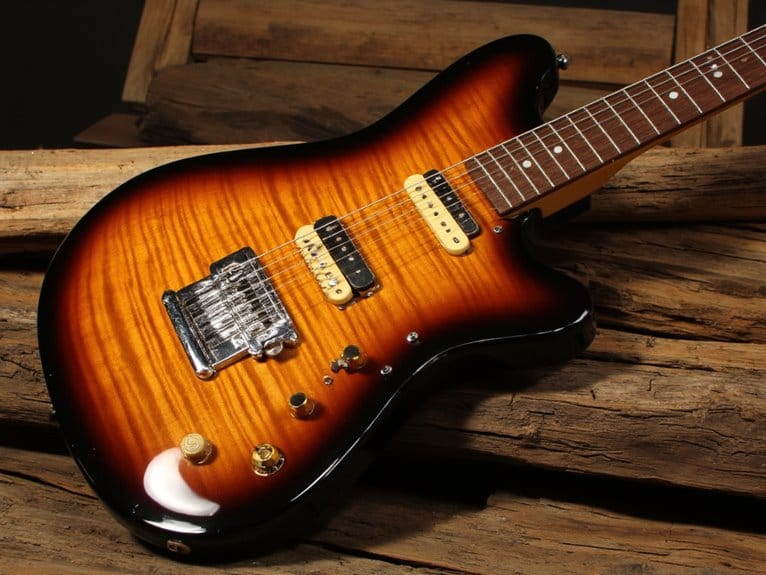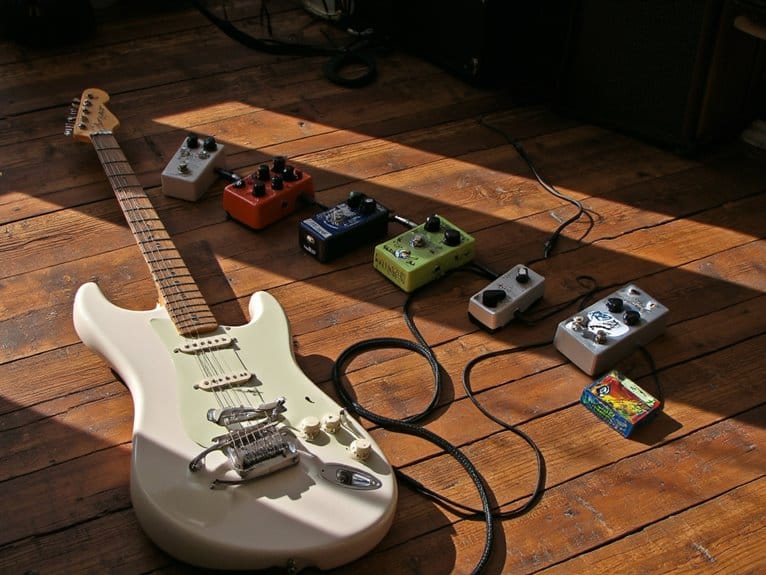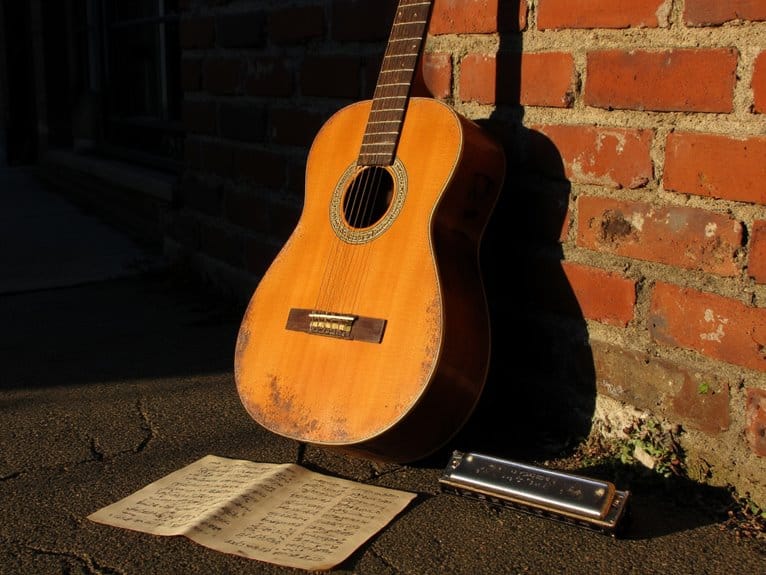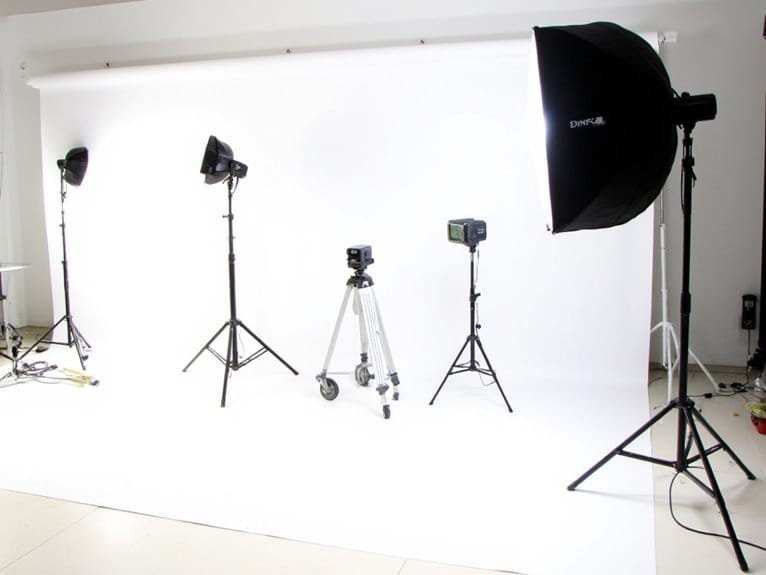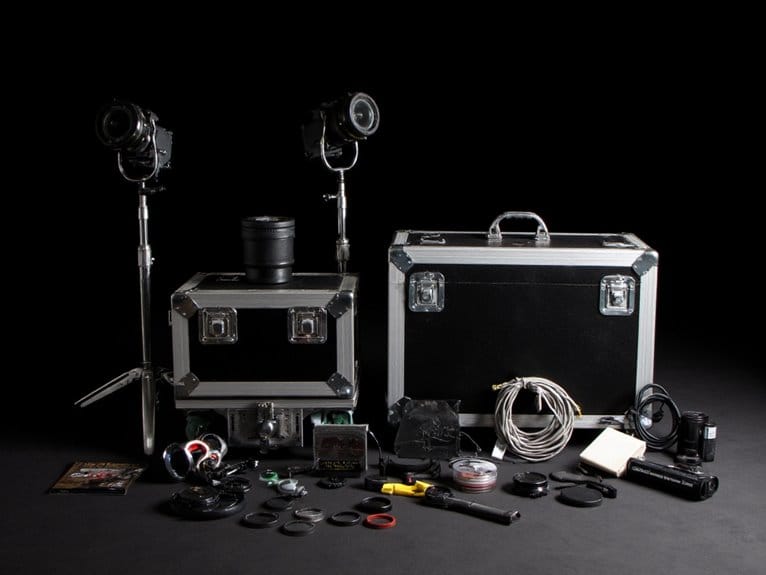Monitor Speakers Vs Headphones for Electronic Drums
You’ll get better spatial awareness and natural bass response with monitor speakers, but they require room treatment and can disturb neighbors, while headphones offer silent practice with intimate sound delivery that eliminates room acoustics issues. Monitors excel for live performance preparation and mixing with their wider soundstage, though headphones provide consistent frequency response regardless of your environment. Budget around $400 for decent monitors versus $50-200 for quality headphones, considering that monitors need amplification while headphones plug directly into your drum module. Below, we’ll explore how each option impacts your specific playing scenarios and long-term development.
We are supported by our audience. When you purchase through links on our site, we may earn an affiliate commission, at no extra cost for you. Learn more.
Notable Insights
- Headphones provide silent practice for apartments and late-night sessions, while monitors require room consideration due to sound projection.
- Monitors deliver tactile bass vibrations and spatial awareness crucial for realistic drum feel, especially for kick drum response.
- Headphones offer plug-and-play convenience with lower cost ($50-$200) versus monitors requiring amplification and higher investment ($400+).
- Monitor speakers reduce ear fatigue during extended practice sessions, while headphones pose higher hearing risks from direct sound delivery.
- Monitors provide natural soundstage for band communication and mixing, while headphones create intimate, focused sound isolation for technique development.
Sound Quality and Accuracy Comparison
When you’re weighing the sound quality differences between monitor speakers and headphones for electronic drums, I’ve found that the choice fundamentally comes down to consistency versus potential accuracy.
Headphones deliver reliable frequency consistency by eliminating room acoustics entirely, maintaining predictable tonal balance regardless of your environment. Premium models like the Audeze LCD-X show frequency variations within 15-20 dB, which I consider quite respectable for consistent performance. Additionally, headphones provide excellent passive noise isolation, allowing you to focus purely on the drum module’s audio output without external distractions.
Monitor speakers, however, offer a wider accuracy range that’s heavily dependent on your room treatment and speaker quality. In ideal conditions with proper acoustic treatment, monitors can actually surpass headphones in absolute accuracy, but they’ll perform poorly in untreated spaces where room reflections distort the frequency response considerably. Well-treated rooms with quality monitors can achieve less than 3 dB variation from a flat response, delivering superior accuracy compared to even high-end headphones. For electronic drum applications, monitors with 5-inch woofers provide better bass response, which is crucial for accurately reproducing the low-frequency content of kick drums and bass-heavy samples. Professional studio monitors require flat frequency response and accurate sound reproduction to ensure your electronic drum sounds translate well across different playback systems. Most quality monitors also include built-in EQ controls for bass and treble adjustments, allowing you to fine-tune the sound to match your room acoustics and personal preferences.
Use Case Scenarios and Environments
Your choice between monitor speakers and headphones for electronic drums depends heavily on where you’ll be playing, since each environment presents unique challenges that favor one option over the other.
Home practice sessions, live performance venues, and studio recording applications each demand different considerations regarding sound isolation, volume requirements, and setup logistics that directly impact your monitoring decision.
I’ve found that understanding these specific use cases helps you match the right monitoring solution to your particular drumming situation, rather than trying to force a one-size-fits-all approach. Monitor speakers also need to accommodate space limitations when setting up your electronic drum kit, which can significantly influence whether they’re practical for your specific playing environment.
Home Practice Environments
Since most drummers practice at home more than anywhere else, choosing between monitor speakers and headphones becomes particularly essential for your domestic setup, where factors like noise control, room acoustics, and space constraints directly impact both your practice quality and household harmony.
For noise management, headphones clearly win since they eliminate sound leakage that could disturb neighbors or family members during late-night sessions. Your equipment setup becomes simpler too, requiring just a direct connection to your drum module without additional amplifiers or interfaces.
However, monitors offer spatial awareness and reduce ear fatigue during extended practice, though they’ll require acoustic treatment in small rooms to prevent muddied sound. Many drummers find that connecting their electronic drums through affordable audio interfaces provides better sound quality and more flexible routing options for both headphones and monitor speakers. The plug-and-play functionality of modern audio interfaces makes setup straightforward for home practice environments without complex configuration requirements.
- Headphones provide complete noise isolation for apartment living
- Mini electronic kits paired with headphones maximize space efficiency
- Monitor speakers require additional room treatment and space allocation
- USB connectivity enables seamless computer integration for both options
For optimal audio quality in either setup, look for equipment with a signal-to-noise ratio between 70-120 dB to ensure clear drum sounds without unwanted background interference during your practice sessions.
Live Performance Settings
Moving from your quiet home studio to the bright lights and booming sound systems of live venues transforms the monitor versus headphones debate entirely, as stage dynamics, band communication, and audience energy create completely different priorities than your bedroom practice sessions.
In live sound environments, monitor speakers excel at projecting your electronic drums naturally into the stage space, enabling essential band communication and maintaining ensemble cohesion that headphones simply can’t match.
However, headphones prove invaluable in noise-sensitive venues like churches or small halls, where volume control becomes paramount.
Performance dynamics shift dramatically when you’re isolated by headphones versus hearing ambient stage energy through monitors, though monitors risk feedback issues that headphones elegantly avoid through their inherent isolation design.
For budget-conscious performers using electronic drum kits under $500, MIDI connectivity allows seamless integration with venue sound systems and backing tracks without requiring expensive additional hardware.
Professional studio monitors like the PreSonus Eris 3.5 with 50-watt Class AB amplification deliver exceptional clarity for drummers who need reliable sound reproduction during rehearsals and smaller venue performances.
Active stage monitors typically require power outputs ranging from 300-500W for smaller venues, while larger events may demand upwards of 1000W output to achieve sufficient sound coverage for electronic drum performances.
Studio Recording Applications
When you step into studio recording territory, the monitor versus headphones conversation becomes laser-focused on accuracy, detail, and workflow efficiency rather than the volume constraints and communication needs that dominate live performance scenarios.
Studio monitors excel at revealing spatial characteristics and mixing dynamics, providing the flat frequency response you need for unbiased sound reproduction during electronic drum sessions.
However, headphones offer consistent monitoring conditions unaffected by room acoustics, making them invaluable for detailed editing work and overdubbing situations where sound isolation becomes critical.
Your choice depends heavily on specific recording techniques:
- Monitors for collaborative sessions – Multiple people can critique drum tracks simultaneously
- Headphones for precise editing – Detect subtle timing issues and articulation details
- Monitors for mix translation – Assess how tracks perform on real-world speaker systems
- Headphones for quiet environments – Prevent sound leakage during simultaneous recording
Professional audio interfaces with zero-latency monitoring capabilities enhance real-time performance for both monitoring options, ensuring your electronic drum recordings maintain tight timing without audio delays. Quality DSP capabilities help mitigate noise and distortion when processing electronic drum signals through your chosen monitoring setup.
When evaluating monitoring equipment for studio use, prioritize systems with signal-to-noise ratios above 80 dB to ensure professional audio quality throughout your electronic drum recording sessions.
Volume Control and Hearing Health
Managing volume effectively becomes essential for your hearing health and overall drumming experience, whether you’re using monitor speakers or headphones for your electronic drum kit.
Headphones deliver sound directly to your ear canal, creating higher risk of hearing damage when you’re not careful with volume settings. Monitor speakers dissipate sound through open air, reducing direct pressure on your eardrums, though they still require proper hearing protection at high levels.
| Feature | Headphones | Monitor Speakers |
|---|---|---|
| Volume Control | Individual adjustment, isolation | Physical knobs, mixing capabilities |
| Hearing Risk | High (direct delivery) | Moderate (air dissipation) |
| Practice Volume | Near-silent possible | Audible to surroundings |
| Physical Feel | Limited vibration | Tactile air movement |
You’ll find monitors encourage natural volume breaks while headphones require conscious volume limiting for safe sessions.
Soundstage and Immersion Experience
When you’re choosing between monitor speakers and headphones for your electronic drum setup, you’ll notice a fundamental difference in how each creates its soundstage and immersion experience.
Headphones deliver an intimate, detailed sound that places you directly inside the mix, while monitor speakers project a more natural, spacious soundstage that mimics how you’d hear drums in an actual room.
The room acoustics in your practice space will greatly impact how monitor speakers perform, either enhancing the immersive experience with proper treatment or potentially muddying the sound with unwanted reflections and resonances.
Intimate Vs Natural Sound
The essence of sound reproduction fundamentally differs between headphones and monitor speakers, creating distinct experiences that’ll dramatically shape how you perceive your electronic drum performances.
Headphones deliver an intimate experience by placing sound directly against your ears, creating focused detail and immediacy that can feel almost uncomfortably close. This proximity emphasizes every nuance but lacks the spatial separation your ears naturally expect.
Monitor speakers provide natural listening by projecting sound into your room’s space, allowing frequencies to interact with surfaces and create authentic three-dimensional placement that mirrors real acoustic environments.
- Intimate Experience: Headphones create “in-ear” sensations with tight, immediate sound delivery
- Natural Listening: Monitors simulate real-world acoustics with proper spatial separation and room interaction
- Soundstage Perception: Speakers allow instrument placement around you versus inside your head
- Physical Immersion: Monitor low-end frequencies provide tactile vibrations you can actually feel
Room Acoustics Impact
While headphones deliver their sound in an acoustic vacuum, monitor speakers transform your room into an active participant in your electronic drum experience, creating a complex interplay between your kit’s digital sounds and the physical space around you.
Sound reflections from walls, ceilings, and furniture shape your drum tones in ways that can either enhance or hinder your playing experience. Your room’s frequency resonances will amplify certain frequencies while dampening others, potentially making your kick drum sound boomy in smaller spaces or causing your toms to lose definition.
Speaker placement becomes essential—positioning them too close to walls often creates bass buildup, while poor room acoustics can muddy your entire mix.
Headphones eliminate these variables entirely, delivering consistent, uncolored sound regardless of your practice space’s acoustic shortcomings.
Frequently Asked Questions
Can I Use Regular Hi-Fi Speakers Instead of Studio Monitors for Electronic Drums?
You can use regular hi-fi speakers for electronic drums, but you’ll face hi-fi limitations like colored sound signatures that compromise sound accuracy compared to studio monitors’ flat, neutral response designed for precise audio reproduction.
On a final note
You’ll find both monitor speakers and headphones serve distinct purposes in your electronic drum setup, and honestly, the “best” choice depends entirely on your specific circumstances, budget constraints, and playing environment. If you’re practicing late nights in shared spaces, headphones offer unmatched isolation and convenience. However, if you’ve got dedicated space and want that authentic drum kit feel with natural soundstage, monitors deliver superior spatial awareness and collaborative playing experiences that headphones simply can’t match.


